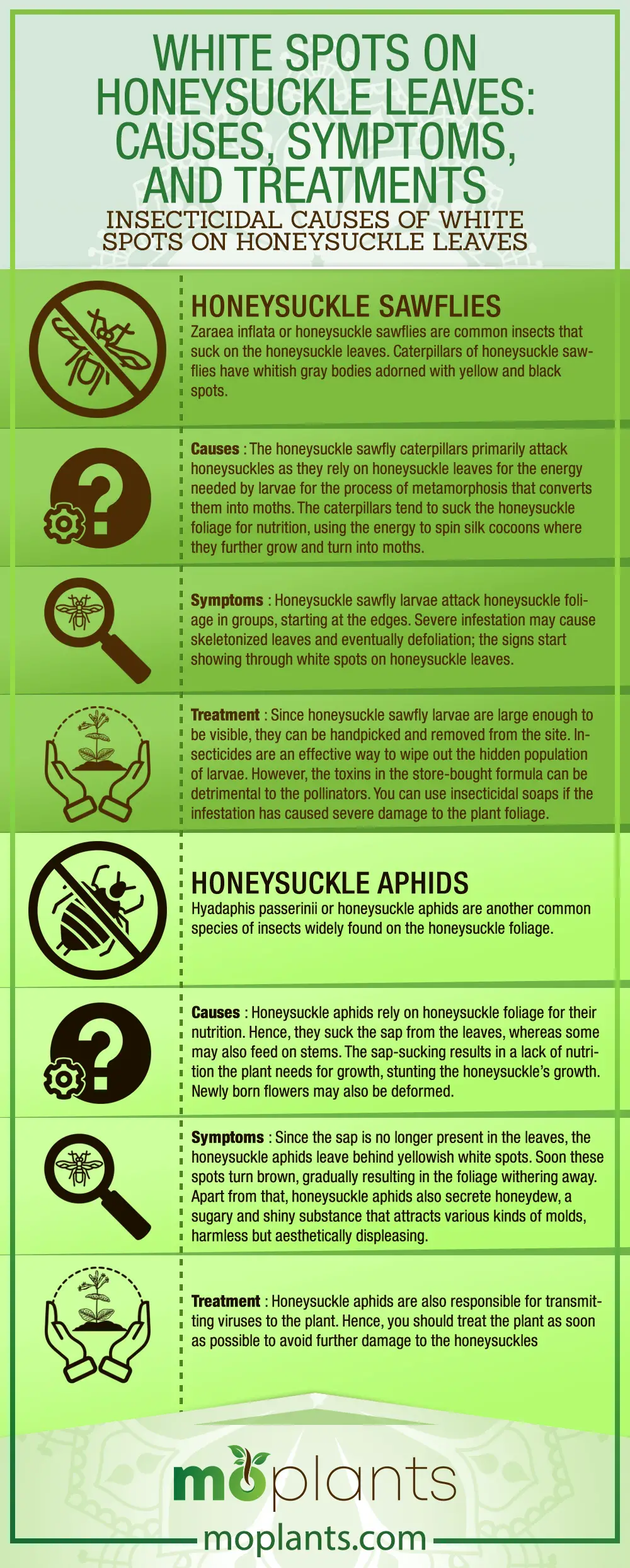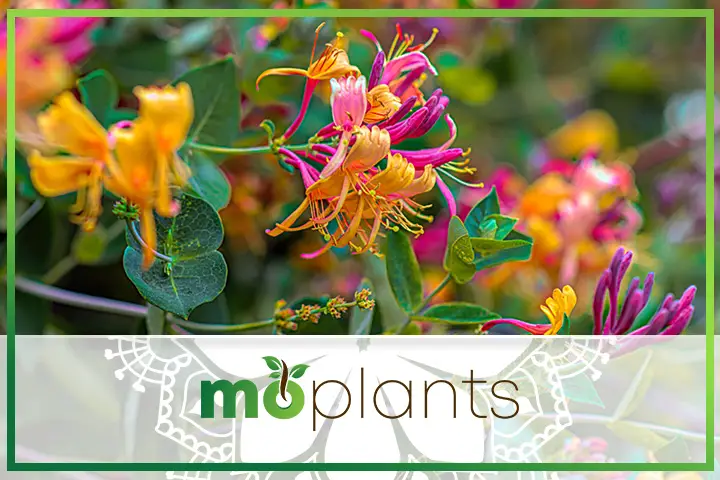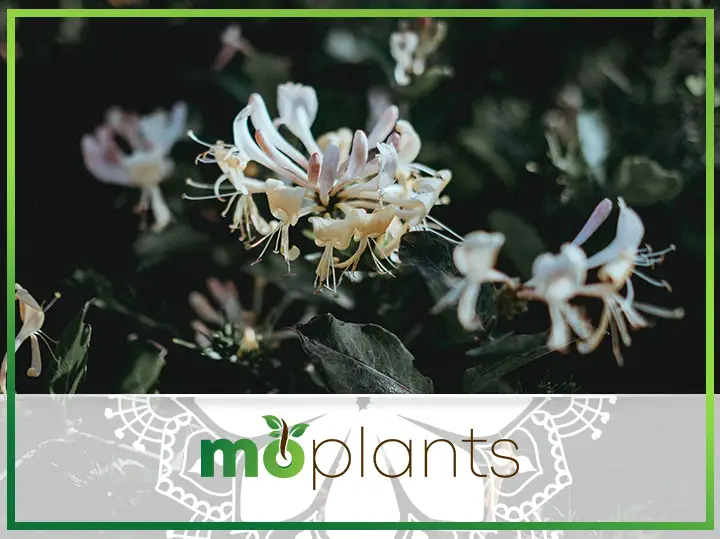Lonicera, known as honeysuckles, are flowering vines and shrubs widely used as ornamentals for landscapes. Belonging to the family Caprifoliaceae, honeysuckles have bilaterally symmetrical flowers, giving the pollinators ample space to conduct pollination. Honeysuckles’ sweet nectar attracts a vast population of hummingbirds, honey bees, butterflies, and bees that gave the genus its name.
While the plant’s nectar successfully attracts beneficial pollinators, it also attracts numerous insects that harm the honeysuckle leaves. Apart from that, the plant is also prone to fungal infections like any other plant genera. The tough plants can survive the attacks. However, these attacks reduce the plants’ ornamental value due to the residual white spots on the foliage.
White spots on honeysuckle leaves are one of the common honeysuckle leaf problems. Since insects and fungi contribute to the problem, it’s often hard to recognize the actual cause. However, distinguished symptoms can aid in diagnosing the disease and help identify appropriate treatments.
This article discusses the insecticidal and fungal causes of the white spots on honeysuckle leaves.
Insecticidal Causes of White Spots on Honeysuckle Leaves
Insecticidal attacks are common amongst plant populations.
Here are some insects popular for leaving white spots on honeysuckle foliage.
Honeysuckle Sawflies
Zaraea inflata or honeysuckle sawflies are common insects that suck on the honeysuckle leaves. Caterpillars of honeysuckle sawflies have whitish gray bodies adorned with yellow and black spots.
Causes
The honeysuckle sawfly caterpillars primarily attack honeysuckles as they rely on honeysuckle leaves for the energy needed by larvae for the process of metamorphosis that converts them into moths. The caterpillars tend to suck the honeysuckle foliage for nutrition, using the energy to spin silk cocoons where they further grow and turn into moths. The process could take a whole year, with adult moths emerging in springtime.
Symptoms
Honeysuckle sawfly larvae attack honeysuckle foliage in groups, starting at the edges. Severe infestation may cause skeletonized leaves and eventually defoliation; the signs start showing through white spots on honeysuckle leaves.
Treatment
Here are some ways you can use to treat a honeysuckle sawfly infestation:
- Since honeysuckle sawfly larvae are large enough to be visible, they can be handpicked and removed from the site.
- Insecticides are an effective way to wipe out the hidden population of larvae. However, the toxins in the store-bought formula can be detrimental to the pollinators.
- You can use insecticidal soaps if the infestation has caused severe damage to the plant foliage.
- For an organic solution, homemade neem oil insecticide can do wonders. Simply mix a tablespoon of neem oil (concentrated) and a teaspoon of soap liquid in a gallon of water. Spray the solution on the affected leaves and drench them, top and bottom, for effective results. You can also spray the insecticide directly on the population of insects.
Honeysuckle Aphids
Hyadaphis passerinii or honeysuckle aphids are another common species of insects widely found on the honeysuckle foliage.
You can find soft, pear-shaped aphids in various colors, including black, brown, and grayish green. Honeysuckle aphids owe it to their small size (2mm to 4mm) for being invisible to the human eye. The insects have sucking mouthparts, whereas the rear end has tailpipes. The adults may have wings.
Causes
Honeysuckle aphids rely on honeysuckle foliage for their nutrition. Hence, they suck the sap from the leaves, whereas some may also feed on stems. The sap-sucking results in a lack of nutrition the plant needs for growth, stunting the honeysuckle’s growth. Newly born flowers may also be deformed.
Symptoms
Since the sap is no longer present in the leaves, the honeysuckle aphids leave behind yellowish white spots. Soon these spots turn brown, gradually resulting in the foliage withering away. Apart from that, honeysuckle aphids also secrete honeydew, a sugary and shiny substance that attracts various kinds of molds, harmless but aesthetically displeasing.
Treatment
Honeysuckle aphids are also responsible for transmitting viruses to the plant. Hence, you should treat the plant as soon as possible to avoid further damage to the honeysuckles.
- Honeysuckle aphids have numerous predators, including the widely present ladybugs. Culturing a population of these insects can naturally result in aphids’ removal.
- Horticulturists often advise leaving aphids to climate conditions. Severe rainfall can easily wash away the cluster of honeysuckle aphids due to their small size. Extreme temperatures have the same effect. At times, wind can also erase a population of aphids effectively.
- If waiting for the right weather isn’t an option, you can always blast off the honeysuckles with water. The targeted watering should eradicate honeysuckle aphids, even the ones hidden underneath the leaf’s surface.
- Insecticides can always play a part in removing an aphid population, but the number of toxins makes these chemicals not worth the investment.
- Insecticidal and horticultural oils can remove aphids well. However, aphids can adapt to the formula of these solutions. Hence, we advise using another treatment method alongside for lasting results.
Infographic


Fungal Causes of White Spots on Honeysuckle Leaves
Fungal attacks are common amongst plant populations. Waterlogged soil can sometimes become a bed for fungal growth, whereas an infected plant can also propagate the disease.
Here are some common fungal diseases that cause white spots on honeysuckle leaves.
Powdery Mildew
Caused by the fungi species Microsphaera alni and Erysiphe polygons, powdery mildew is a widely known fungal disease amongst ornamental plants. The spread of the disease may be caused by using contaminated pruning knives or other planting equipment. Movements aided by wind and moving insects also spread the disease among the honeysuckles by moving the spores of fungi from one plant to the other. A unique characteristic of powdery mildew is that it grows rapidly in dry weather, unlike numerous other fungi.
Causes
Powdery mildew is famous for creating a powdery white layer or weblike structure on a leaf’s surface. Though initially harmless, the disease can become detrimental if the leaf surface is entirely covered by a dense layer of the fungus, resulting in blockage of sun rays. Since the fungus hinders photosynthesis, the honeysuckle foliage eventually turns brown and drops off.
Symptoms
Powdery white spots on honeysuckle leaves indicate the growth of powdery mildew disease on plants. The disease has the same symptoms regardless of the plants because of a distinguished growth pattern of the fungi.
Treatment
Here are some of the treatments advised by botanists and horticulturist experts on how to treat powdery mildew on honeysuckle:
- Fungicides are the most effective way of killing the fungus population immediately. However, the toxic chemicals may harm hummingbirds, making the method quite debatable.
- Organic fungicides or horticultural oils work like magic when erasing powdery mildew. The trick is to completely soak the leaves with these solutions to effectively remove the white powdery patches and the fungus. However, we advise spraying the solutions below 90 F and always water before application.
- Homemade solutions also show significant removal of powdery mildew. Prepare a solution by mixing a gallon of water with a tablespoon of sodium bicarbonate (a common household item known as baking soda) and one teaspoon of soap liquid. Mix well and spray on the diseased foliage, especially on the bottom, less visible parts.
Honeysuckle Leaf Blight
Glomerular lonicera is the fungus species responsible for another prevalent leaf disease among honeysuckles and plants. Rainy weather is usually a catalyst for this fungus as moist conditions are perfect for fungal growth. As a result, the leaf could wither and drop, though the plant’s health remains unharmed.
Causes
A high density of plants grown in a small area hinders the aeration and results in low evaporation, making the conditions around the plant moist. These elements work perfectly together to create a ground for the growth of fungus, causing honeysuckle leaf blight.
Symptoms
The plants suffering from honeysuckle leaf blight will only show signs on leaves. The leaves may become brown and spotty while curling on the edges. You can also observe a white spot on honeysuckle leaves. These spots indicate the presence of the actual fungus. This silvery-white patch is likely on the leaf’s underside.
Treatment
Here are some common ways you can use to treat honeysuckle plants for leaf blight.
- Pruning is the easiest way to eliminate the diseased leaves that could otherwise propagate the disease to other plants. After pruning, carefully discard the affected foliage to avoid the chances of contamination.
- Irrigating at scheduled hours is crucial to avoid the growth of the fungus. Since honeysuckle plants are drought tolerant, we advise you to water them less or in morning hours when ample sunlight can easily evaporate any excess water instead of logging the soil or freely running around the leaves.
- Fungicides are the most effective way of erasing the cluster of fungi that causes leaf blight. Fungicides labeled with copper work the best. However, keep track of the number of doses to avoid overdoing the fungicide, which could ultimately harm the plant’s health.

How to Prevent Honeysuckles from Diseases
Plants are prone to diseases regardless of their location. As a natural habitat for numerous species of insects and a perfect ground for the growth of fungi, honeysuckle plants are likely to contract diseases time and after, decreasing their ornamental value. You can adopt preventive measures to avoid or prevent the spread of such diseases.
- Always leave gaps when planting honeysuckle plants, climbers, or shrubs. Densely packed plants will reduce aeration and provide perfect growth conditions for fungi.
- The soil used for planting honeysuckles must be fertile and drain well to allow the best growth for the plant.
- Pay close attention to the irrigation cycle of the plant. Make sure you have a watering schedule. Damp soil is perfect for fungal diseases that can stunt plant growth.
- Overwatering the plant is another major issue that can cause severe damage to the roots affecting the overall growth of the plant.
- Ensure to scrape away all the fallen foliage to allow the flow of air within the soil and the plant smoothly.
- Whether creating a bed or planting in a container, it is advised to dry fry the soil for honeysuckles. This method aims to reduce the chances of fungal growth in the soil. Initially, spray the fungicide in the soil and let it sit in the sun for a few days.
- Compost or manure is where most of the insects reside and breed. Growing honeysuckles near such an area can easily attract a large population of numerous insects, affecting the plant’s health.
- While some plants grow perfectly in shades, that’s not the case for honeysuckles. Honeysuckle flowers bloom and look wonderful when planted underneath direct sunlight. The UV rays also keep the pests away from the plant while increasing the evaporation rate to avoid waterlogging.
Conclusion
Horticulturists use honeysuckles as ornamental plants to adorn landscapes with brightly colored and unique petals. However, the white spots on honeysuckle leaves can significantly reduce the appeal of the flowers. Hence, if you’re looking for ways to get rid of these white patches on the leaves, you must first be aware of what causes these honeysuckle leaf problems to treat the diseases effectively.
Insects and fungi are responsible for white spots on honeysuckle foliage. Where the attacks of aphids and honeysuckle sawflies are extremely common, these infestations can harm the plant’s overall health. Apart from that, honeysuckle leaf blight and powdery mildew are common fungal diseases. The fungal diseases may not directly affect the plant’s health but cause severe damage to the honeysuckle foliage, contributing to the reduced aesthetic appeal of the flowers. While the treatments of these diseases are possible, so is prevention. Always plant the honeysuckles with extreme care to prevent the growth of fungus or the population of insects.

